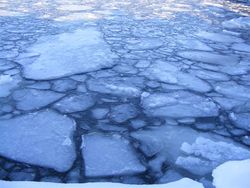Winter often offers a frozen lake for skating, fishing, and myriad other activities. Throughout the winter you can watch for changes in the ice as it continues to grow, shrink, and move. Three phenomena that demonstrate the dynamic nature of ice are tension cracks, pressure ridges, and ice ramparts.
Tension cracks form when the ice molecules pull apart as the ice continues to cool. As the ice expands, the molecules within the sheet pull away from each other creating tension. The addition of even a slight amount of pressure, like from a walking person, can relieve the tension and allow a thin fissure to appear usually accompanied by a loud snap.
Pressure ridges result from the buckling of ice as it expands when it warms. Eventually the buckling leads to cracks, and one sheet of ice shoots up over another. The cracks form at right angles to the movement of the expanding ice. The process is similar to how mountains form.
Ice ramparts form when the expanding sheet of ice pushes against the shoreline rather than against more ice. The pressure from the expanding ice can force gravel and stones on to the land. Ice ramparts can cause severe damage to shoreline property or docks that may have been left in the water.
